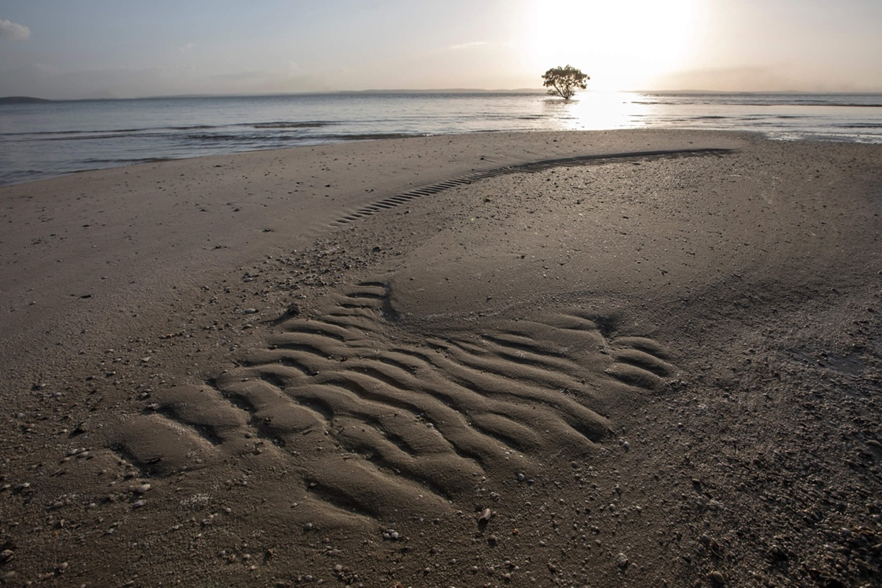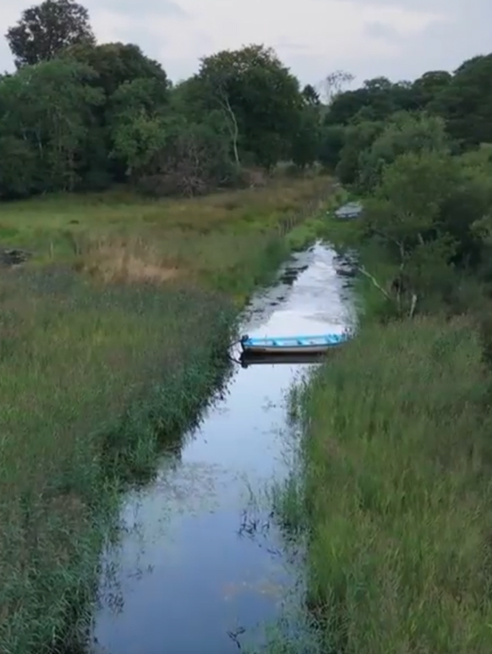Attunement to Country: Creating Knowledge Together
- 2 August - 11 October, 2025
Midpul Art Gallery, Charles Darwin University (CDU), Larrakia Country, Northern Territory
Two Exhibitions: MILKUM GA WALŊA: Pattern, camera, life and RAŊIPUY: The beach is breathing.
Räl-manapanmirr – if there is no relationship, there is no care. No recognition.
— Paul Gurrumuruwuy Wunungmurra, Yolŋu creative and academic (1955–2024)

Yolŋu Country. Image supplied by Miyarrka Media
Walking into the Midpul Gallery from the early summer heat and the busy streets of Darwin’s CBD, I am halted by the tonal sounds of lapping water and soft voices – Yolŋu and balanda. I breathe in. I breathe out. Over several days, I return multiple times, moving back and forth into this watery space of raŋi and gapu – the beaches and saltwater of Yalakun on Yolŋu Country.
In the gallery are two exhibitions honouring the legacy of creative and academic Paul Gurrumuruwuy Wunungmurra. Coordinated by the arts collective Miyarrka Media, the exhibitions are MILKUM GA WALŊA: Pattern, camera, life and RAŊIPUY: The beach is breathing.
The main gallery holds RAŊIPUY: The beach is breathing. In the far corner, a video shows Paul Gurrumuruwuy Wunungmurra, chest-high in saltwater, saying, “raŋi has precious gifts to share.” In another video, a Yolŋu woman, who I later learn is Wunungmurra’s eldest daughter, Gurunulmiwuy, asks visitors to “bring your whole being closer to the saltwater and the sand.” Raŋipuy. Each work in the gallery speaks to a relationship of care, reaching “out to anyone who has a beach that lives inside them.”
In this relationality, I drop my habitual, objective observer stance and let the voices, sounds, and patterns of waves, colours, and shimmering light wash over me. I connect with the beach inside me, which is simultaneously tied to the raŋi and gapu, the beaches and saltwater of Yalakun.

Leamore Bog, My Mothers Country, Wicklow, Ireland. Image: Wendy Cowan
I remember – not so much a beach as a living bog in my mother’s country, Wicklow, Ireland, a water-filtering kidney that opened into a pebbled beach. As a child, my cousins and I spent days foraging, for berries and mushrooms, jumping wet spongy grassy clumps, pushing boats along channels, lying on our stomachs, eye-level with water birds, flowers, mosses, and insects. It was the era of unregulated parental supervision. Expected back before dark for dinner, we had all the time in the world to dream up our storied relationality to this ‘walking on water’ peatland.
Today, some fifty years on, the strong sense of smell, taste, weather, adventure, and care for this meeting of salt and freshwater is indelibly stamped in my psyche – shaping how I carry myself in the world. By 2025, most of these waterways have been drained for the grazing of cattle and sheep.
I now live in Mparntwe-Alice Springs, where I regularly walk the ridges that hold this town. This is dry, arid Country which, 800 million years ago, held a shallow inland sea. I know in my bones, as well as in my intellect, that these rocky ridges are not separate from the country of my birth, Ireland. This recognition is a means of care: “Bäla-räli djägayunmirr – I look after you, you look after me. And so, we hold each other.” I am no longer separate from this place, and this place is no longer separate from me. This recognition is both powerful and vibrant.

Images supplied by Miyarrka Media
The second exhibition, MILKUM GA WALŊA: Pattern, camera, life, shares Paul Gurrumuruwuy Wunungmurra’s unique vision for research, shaped through his postdoctoral work at the Centre for Creative Futures at Charles Darwin University (CDU) and his close familial and intellectual connection with academic Jennifer Deger.
Wunungmurra’s approach to knowing is grounded in attentiveness to creation – research as enlivenment and regeneration: never static, never distant, never abstract. In this world, relational practices emerge in composition-with Country. Wunungmurra is not interested in the work of anthropologists who arrive in Arnhem Land to take notes, record songs, and collect data to analyse elsewhere. Instead, he is attentive to the movement of knowledge through bodies – his own, through saltwater, through Yolŋu and balanda working together, through feelings and pattern-making. In this way, Wunungmurra and the art collective Miyarrka Media practice research as an ethic of reciprocity, responsiveness, and renewal.
As an artist and mentor with the intra-cultural storytelling collective Stick Mob Studio on Arrernte Country, Central Australia, I felt deeply connected and shaped by the words, sounds, and images so generously shared across both exhibitions. I left the space humbled and energised by how collective and grounded ways of thinking and creating shape analysis differently – and why this attunement matters to relational knowledge creation.
Wendy Cowan, born in Enniscorthy, Ireland, is an artist-mentor-writer based in Mparntwe-Alice Springs, where she works-with Stick Mob Studio, an intra-cultural collective of storytellers.